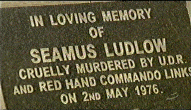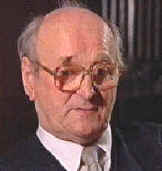| Questions |
Who was Seamus Ludlow?
Seamus met his death on the night of 1st. and 2nd. May 1976. After spending the evening in various Dundalk public houses, Seamus left the Lisdoo Arms, on the Ni road just north of Dundalk, around 11.30 pm. He was last seen standing outside Smith's Garage nearby, thumbing a lift for the three mile distance to his home, as he had done on many occasions before. The memorial, shown at the top of this page, marks the spot where Seamus Ludlow's body was found on Sunday 2nd. May 1976. Where can I find more information about Seamus Ludlow?The Ludlow family has produced another web site The Seamus Ludlow Truth and Justice Campaign. This web site has detailed accounts of Seamus Ludlow's family background, the last day of his life, and the Ludlow family's unsavoury treatment by the Gardai in the aftermath of the murder. There are press reports of Seamus Ludlow's murder from the Sunday Press and the Sunday World and a Special Report from the local Argus newspaper in 1985. There are accounts of recent revelations in the press about the arrest of four Loyalist suspects from County Down in February 1998 and the Irish Victims Commission's report of 1999. There is a copy of a Profile on Seamus Ludlow's death, compiled by a member of the family. There is also a copy of the text of an independent report produced by the respected human rights body British Irish RIGHTS WATCH (BIRW), London. Further information about recent developments can be found on the web sites of the Pat Finucane Centre and BIRW. Back to TopWho killed Seamus Ludlow, and why. ?The first part of this question is easier to answer than the second part. Despite false claims spread by the Gardai in southern Ireland and by the British Army in the Six Counties, to the effect that Seamus Ludlow was an informer who had been murdered by the IRA, forces of a different hue were responsible. The Ludlow family emphatically maintain that Seamus Ludlow was no informer. He was not killed by the IRA. Recent revelations of an RUC and Gardai cover-up dating from the 1970s show how in fact it was known all along that Seamus Ludlow was the victim of a Loyalist/British Army murder gang. It is now known that the RUC in Belfast handed a file on the killing to the Gardai in 1979. This file contained the names of at least three of the suspects who were arrested by the RUC nearly 20 years later, in February 1998. It has also emerged, from statements made by one of the suspects, that he was questioned about the murder by the RUC Special Branch in 1987, and that he was told to say no more about Seamus Ludlow because it was "political". Why Seamus Ludlow was killed remains a mystery. Perhaps we should be asking what the four Loyalist suspects, including two members of the British Army's Ulster Defence Regiment (UDR), from far off Comber and Newtownards in north Down, were doing in Dundalk on the night in question. Were they engaged in a drinking spree as it has been suggested, or were they on a mission of murder. Seamus Ludlow was totally unknown to them. Could it be that he was just another Catholic or a victim of mistaken identity, killed instead of another intended victim, who may have been a republican. There have been persistent rumours that Seamus bore a strong resemblance to one man in particular who may have been on a death list . Back to TopWhy was Seamus Ludlow's murder covered up?This is the question that has yet to be answered, hopefully at a public inquiry. The Ludlow family rightfully feel that those (whoever they are) who participated in this shameful neglect of duty, and perverted justice, must be forced to answer for their abuse. Gardai officers were paid and sworn to uphold the law, solve or prevent crime, and to protect members of the public from crime. Certainly in the case of Seamus Ludlow's murder, and in every other case where Loyalists committed murder in the Irish state - in Dundalk, Castleblaney, Dublin, Monaghan, Buncrana and Sallins - with perhaps fifty innocent victims - the Gardai have manifestly failed in that duty. In the case of Seamus Ludlow it is clear that there was a cover-up. Members of the Gardai have admitted this to members of the Ludlow family. A secret file containing the names of at least three suspects had been gathering dust for some twenty years, even while Gardai in Dundalk were constantly assuring members of the Ludlow family that there was no other file, and there were no other suspects. It has recently been reported that this RUC file had been passed to several high-ranking Gardai officers - including an Assistant Commissioner - yet no action was taken. Several officers, and others in retirement and still living, should have interesting answers to give when, or if, they are forced to testify. It has been suggested that the cover-up was inspired by a need to protect one of the Loyalist killers who may have been an agent working within the death squad. If true, this agent, who may have been the actual killer, may well have reported back to his RUC Special Branch, British Army or MI5 handlers immediately. He may have given them a detailed report about the killing of Seam Ludlow. The Gardai's handling of Seamus Ludlow's inquest on 19th August 1976 also leads to suspicions of a cover-up. No members of the Ludlow family were present, simply because no one within the family was given sufficient advance notice. Clearly, Ludlow family members were not wanted there. The inquest reports in the local press and the state pathologist's report say nothing about the calibre of weapon used to kill Seamus Ludlow. This neglect fuels suspicions that a British Army/UDR weapon was used. Such a weapon would have identified the killers immediately. The Ludlow family demands a public inquiry to uncover the answers to all of the important questions raised about the official cover-up of the murder of Seamus Ludlow. These questions have been raised in previous communications between the family and its legal representative and the authorities in Dublin and Belfast. The absolute necessity for the holding of a public inquiry has been argued vigorously. As this page was in construction, the Ludlow family was still waiting for an official response from the Irish Minister for Justice Back to TopWho leads the Ludlow family's campaign for a public inquiry.
The Ludlow family has established an Appeal Fund (see below) to help with securing the necessary funds for a campaign which will continue to drain available resources for some time to come. Any donations, to the Appeal's account at the Bank of Ireland, Dundalk, of whatever size, will be deeply appreciated. Back to TopWho supports the Ludlow family?The Ludlow family continues to enjoy the active support of respected human rights groups like British Irish Rights Watch (BIRW), London, the Pat Finucane Centre (PFC), Relatives for Justice, and the Irish Council for Civil Liberties. BIRW has produced an independent report on Seamus Ludlow's death and its esteemed Director Jane Winter has twice flown to Ireland to accompany members of the Ludlow family on important occasions - the most recent being a meeting with the Irish Minister for Justice. The Pat Finucane Centre, Derry, and Relatives for Justice, Belfast, have been particularly supportive, having invited the family to their recent conferences for relatives of victims of state violence. PFC has featured the Seamus Ludlow case on its own website, including much of the recent output of journalist Ed Moloney for the Sunday Tribune newspaper. The Pat Finucane Centre published this site on its website and on its email newsletter. Through PFC's efforts, this site has gained a considerable hit rate in a very short time. Relatives for Justice kindly invited the Ludlow family to send a representative to join their deputation for a meeting with Taoiseach Mr. Bertie Ahern in Dublin. Both Newry and Mourne District Council and Louth County Council have supported the Ludlow family's demand for a public inquiry into the death of Seamus Ludlow. The Ludlow family is also supported by a number of Irish TDs and senators and British MPs. Since the launch of this second Ludlow family website, it has been obvious that the Ludlow family's campaign for truth and justice has many good friends at home and abroad. This is obvious from a visit to the site's Guest Book, where several messages have been posted by good friends in the United States and Britain. Members of the Irish Organisations United in Pennsylvania and Massachussetts are now actively campaigning on the Ludlow family's behalf. The Ludlow family's campaign is also supported by members of Friends of Irish Freedom in the United States. The campaign has also secured from members of the Connolly Association. Most of all, the Ludlow family is pleased to report that their concerns and their demands for truth and justice are widely supported in their local community on both sides of the border. Back to TopSUPPORT THE SEAMUS LUDLOW APPEAL FUND Bank of Ireland Account No. 70037984 Thank You. |
Webspace donated
by Thirtytwo.Net |
 Seamus Ludlow, was a 47-year-old
Catholic bachelor who lived at Thistlecross,
Mountpleasant, Dundalk, County Louth, Ireland,
just a short distance south of the border
and the Six Counties. Seamus lived in his
lifelong home with his elderly mother and his
married sister and her family. Seamus worked with
his brother-in-law Tommy Fox (now deceased) as a
forestry worker in the vicinity of his home.
Seamus Ludlow was murdered by Loyalists from the
Six Counties in May 1976. His killers have never
been brought to justice, and his family want to
know why this is so.
Seamus Ludlow, was a 47-year-old
Catholic bachelor who lived at Thistlecross,
Mountpleasant, Dundalk, County Louth, Ireland,
just a short distance south of the border
and the Six Counties. Seamus lived in his
lifelong home with his elderly mother and his
married sister and her family. Seamus worked with
his brother-in-law Tommy Fox (now deceased) as a
forestry worker in the vicinity of his home.
Seamus Ludlow was murdered by Loyalists from the
Six Counties in May 1976. His killers have never
been brought to justice, and his family want to
know why this is so. The
Ludlow family's search for truth and justice is
led by Kevin Ludlow, the only surviving brother
of Seamus Ludlow. Kevin Ludlow has maintained
close contacts with the Gardai ever since his
brother was murdered in May 1976. On several
occasions he was deliberately misled. He was even
told that a member of his own family was involved
in his late brother's murder! He was even given
the name of a particular relative. With his
nephew Jimmy Sharkey, he has worked tirelessly to
uncover the full truth behind his brother's
murder and the reasons for the Gardai's failure
to solve the crime.
The
Ludlow family's search for truth and justice is
led by Kevin Ludlow, the only surviving brother
of Seamus Ludlow. Kevin Ludlow has maintained
close contacts with the Gardai ever since his
brother was murdered in May 1976. On several
occasions he was deliberately misled. He was even
told that a member of his own family was involved
in his late brother's murder! He was even given
the name of a particular relative. With his
nephew Jimmy Sharkey, he has worked tirelessly to
uncover the full truth behind his brother's
murder and the reasons for the Gardai's failure
to solve the crime.